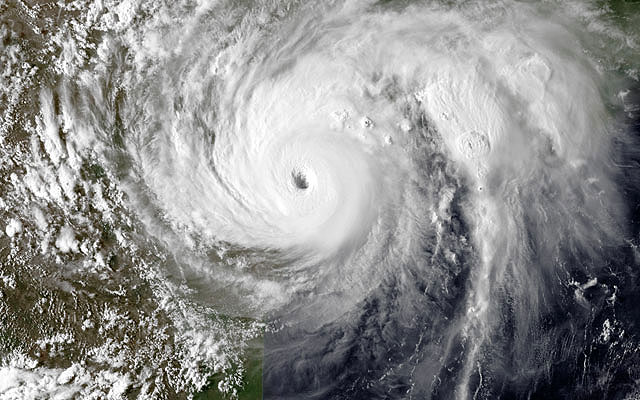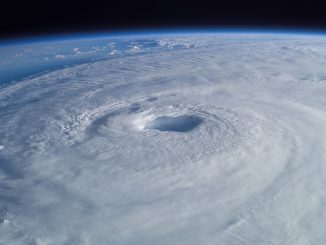Hurricane Harvey’s deadly rainfall is so much worse than Hurricane Katrina’s, which hit New Orleans in 2005.
Katrina brought havoc through the strength of its wind and record-breaking storm surge.
But, Harvey’s staggering rainfall of up to 50 inches — more the amount that Houston receives in a year — brought a frightening deluge that Texas has never experienced before.
More than 300,000 people were without power.
Tens of thousands of homes were semi-submerged and thousands of people were seeking emergency shelter.
Following the hurricane’s landfall, the US Coast Guard reported that it was receiving more than 1,000 calls per hour from terrified residents needing assistance. The Houston Fire Department had been also inundated with calls.
Air and boat rescues were immediately conducted. But, efforts had also suffered delays due to people’s panic.
And even as the slow-moving deadly storm started to shift, the National Hurricane Center – National Oceanic and Atmospheric Administration, warned that “catastrophic and life-threatening flooding will continue in and around Houston eastward into southwest Louisiana for the rest of the week.”
What Made Harvey an Extraordinarily Destructive Storm?
According to the National Hurricane Center (NHC), a hurricane is measured based on its sustained wind speed.
The Saffir-Simpson Hurricane Wind Scale is used to rate hurricanes from 1 up to 5:
- Category 1: Maximum sustained winds at 64-82 knots (119-153 km/hr or 74-95 mph). Some damage is expected to be sustained due to “very dangerous” winds. The force of the winds could damage house roofs, break tree branches, and cause power outages due to damaged power lines and poles.
- Category 2: Maximum sustained winds at 83-95 knots (154-177 km/hr or 96-110 mph). Extensive damage is to be expected due to “extremely dangerous” winds. It could cause more serious damage to house roofs and sidings, tree uprooting, and near complete loss of power.
- Category 3: Maximum sustained winds at 96-112 knots (178-208 km/hr or 111-129 mph). A major hurricane that is expected to cause devastating damage. House roofs might be flown away and more trees broken or uprooted, resulting to roads getting blocked. Water and electricity supplies would get cut off due to damaged lines for several days until the hurricane passes.
- Category 4: Maximum sustained winds at 113-136 knots (209-251 km/hr or 130-156 mph). A major hurricane that is expected to cause catastrophic damage. Houses could lose their walls and roofs. Trees could get knocked down and power poles could fall. Residential areas would suffer isolation, with most affected areas becoming uninhabitable for some weeks or months.
- Category 5: Maximum sustained winds at 137 knots or higher (252 km/hr or 157 mph, or higher) A major hurricane that is expected to bring catastrophe, destroying many homes and isolating residential areas due to fallen power poles and trees. Power outages may last weeks or months, with most of the affected areas uninhabitable for a long period.
Harvey was a Category 4 Hurricane, but NHC has noted something unusual about it according to a National Geographic report.
A hurricane’s intensity usually weakens as it approaches land. This is due to its losing accessibility to hot and wet ocean air which gives the storm its strength. But, with Harvey, its wind speeds gained intensity by approximately 45 miles per hour in the last 24 hours before making its landfall in Texas.
“Hurricanes are powered by the evaporation of sea water,” Kerry Emanuel, an atmospheric sciences professor at the Massachusetts Institute of Technology, says. “Water evaporates faster from a hot surface than a cold surface.”
Earlier this year, Emanuel published a spear-heading research entitled, “Will Global Warming Make Hurricane Forecasting More Difficult?”
According to Emanuel, “Climate change potentially affects the frequency, intensity, and tracks of tropical cyclones. To account for all of these changes, it is necessary to apply comprehensive climate models that simulate the response of both winds and thermodynamic conditions to changing climate.”
In a way Emanuel made an evolution analysis of 6,000 simulated storms, making a comparison on their evolution in the 20th century and possible evolution at the end of the 21st century in terms of whether or not the levels of greenhouse gases continue to increase.
The outcome?
A hurricane that gains intensity by 60 knots in the 24 hours before it makes landfall may have been likely to occur once in 100 years in the 19th century. However, due to a different condition now prevailing, this kind of hurricane could occur every 5 to 10 years by the later part of 21st century.
Tropical storm Harvey started to form in the Gulf of Mexico, where an increase of more than 2 degrees Fahrenheit has been already observed. It has become warmer compared to its temperature 30 years ago, relates Andreas Prein of the National Center for Atmospheric Research.
Due to heat accumulation on the ocean’s surface caused by climate change, more water vapor is formed and a storm picks it up. What’s more, a hurricane gets even stronger because our atmosphere is also warmer which dangerously levels up its capacity to hold more moisture.
And, unfortunately, Texas became Harvey’s dumping ground of the enormous water it sucked from the ocean and the atmosphere.
What’s worse, since atmospheric temperature’s unusually high, Harvey’s been sucking in the very moisture of the rain it has dumped and made it fall back on land again and again.
Another Bad Luck which did not Come from Climate Change
Texas would not have suffered so tremendously if only Harvey were fast in moving northward.
But the hurricane got stalled by two high-pressure systems located over the Southwest and North which were attempting to push Harvey in opposite directions.
As a result, Harvey hovered menacingly over Texas for days.
However, stalled weather systems are natural according to climate scientists and it’s not attributable to climate change.
Yet, this claim is acceptable only at the moment since evidence on this area is still lacking. Further studies have to be conducted to establish whether climate change is also a factor to stalled weather systems which have been also becoming more frequent as reported by the National Aeronautics and Space Administration (NASA).
What’s for sure, when a deadly weather system like Harvey gets stalled, devastation becomes a painful, terrifying nightmare that will haunt victims for the rest of their lives.
- Bulenox: Get 45% to 91% OFF ... Use Discount Code: UNO
- Risk Our Money Not Yours | Get 50% to 90% OFF ... Use Discount Code: MMBVBKSM
Disclaimer: This page contains affiliate links. If you choose to make a purchase after clicking a link, we may receive a commission at no additional cost to you. Thank you for your support!





Leave a Reply